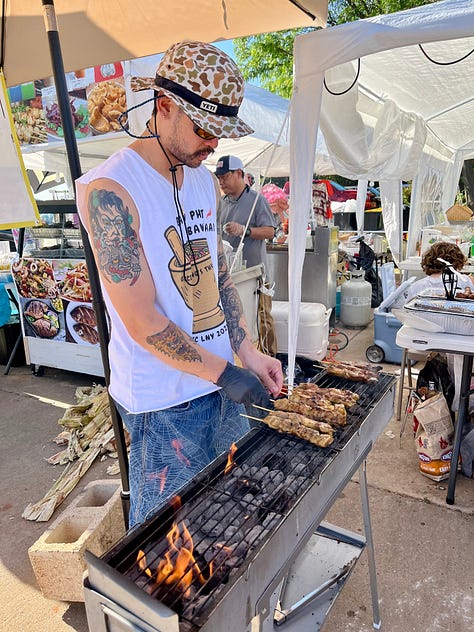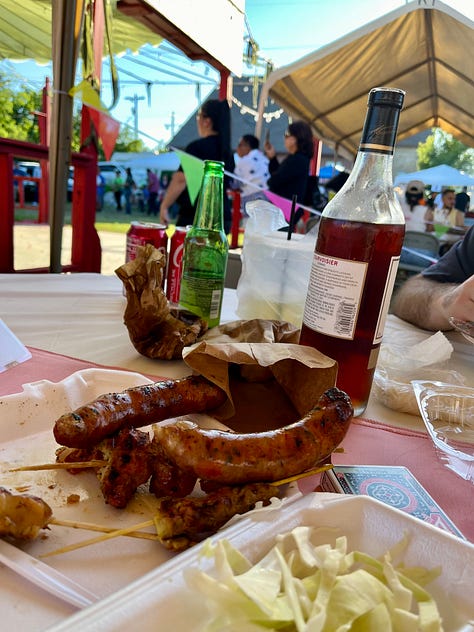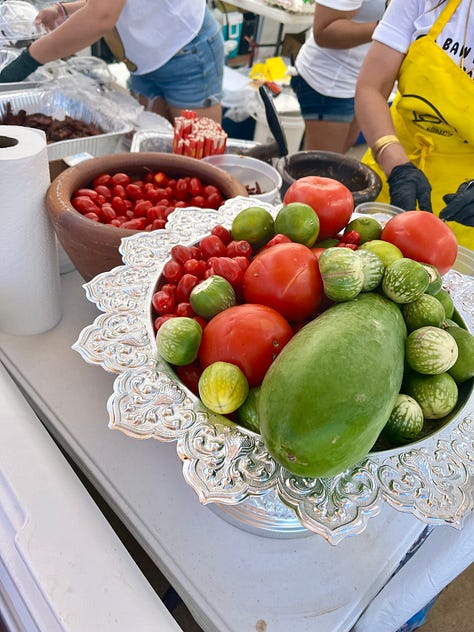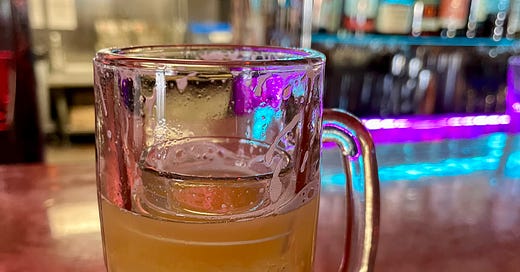“If he takes your hand in his mouth don’t pull out, cuz your skin will rip to shit on his teeth.”
The guy is two empty barstools away: red bearded, in an OKC Thunder cap, with ball shorts in the tortured kind of long-seated twistiness that give his thighs no doubt sticky contact with the stool in this heat. He has a dog on a leash—a cute sort of amber-colored mutt, practically still a pup, nuzzling my hand that might end up in his mouth but thankfully, so far has not.
Edna’s is a large and rambling dive bar in Oklahoma City. I’m here on the advice of Jeff Chanchaleune, chef and owner of Ma Der, a Lao restaurant here, and an amazing place on a couple of levels. Jeff told me to hit up Edna’s for its particular tang of OKC: the dollar bills with graffiti’d names and messages I don't bother to study taped to practically every open patch of ceiling and wall, cascading in places like faded accordion-fold party streamers in shades of pocket-beaten green
.
Jeff told me to drop in on Edna’s for the vibe, and for the Lunchbox, a concoction of Amaretto, orange juice, and Coors: just about ideal refreshment for an afternoon slumping into the 90s, a day when your back secretes an uncomfortable fixative for even the thinnest cotton shirt. I’m parked in back, after following wrong-way signs to a vast lot. I pulled up next to the only other car, a silver sedan hoisted on a jack since one of its wheels is gone.
In the bar, a tall young guy seated with half a dozen women at a high top walks to the bar to order, nods, and says hello to me as he waits. They’re all from some local college, he tells me in a lolling Zach Bryan prairie-boy accent; they’re learning to be vet techs and dog groomers. One by one the women come to the bar, asking for variations on the Lunchbox: the Tootsie Roll, the Jolly Rancher, the Zombie.
I’ve committed to the classic.
“With a Lunchbox,” Jeff advised me earlier at lunch, over a bowl of really good pho, “you have to chug it. Just throw it down in one go.”
I don’t though.
The first sips are of OJ concentrate–flavored macrobrew—not the worst thing to gulp from a frosty mug on a sultry day—but then I notice the shot glass of Amaretto emerging in my mug, lurking depth-charge fashion. My next sip is mostly Amaretto: a syrupy slide beneath a synthetic bitter almond bite so punishing I almost wish I could feel the needle teeth of a pup against my skin, to distract from the sticky chemical miasma. I should’ve listened. But then, what do I know?
In the summer of ’22, my husband Perry and I were on a road trip from Chicago, headed home to Tucson. We stopped for a night in Oklahoma City, found ourselves in the Plaza District, and gravitated to Ma Der, about which we knew absolutely nothing. The food was delicious—fried chicken, and mushroom stew, sticky rice and Lao chile dips with a fire and pungency—a self-assuredness—that surprised us, all our ignorant assumptions about OKC and the sort of food we imagined diners here embracing. I spotted, behind Ma Der’s bar, the book I wrote with James Syhabout, Hawker Fare. I posted about it on Instagram, and Jeff reached out to say how much he loves that book.
Since we connected, Ma Der’s landed on lists in Bon Appétit and the New York Times, and Jeff’s been a multiple James Beard Awards finalist (including this year) for Best Chef Southwest. Takes me long enough, but I finally make it back to Ma Der to meet Jeff irl. He’s promised to show me the OKC he grew up in; the one he loves. For me, it’s a chance to explore a place that, as a native and longtime resident of the SF Bay Area, I never thought about. A chance to be amazed by the resilience of cooking traditions; by the power of a cuisine that’s been misunderstood, certainly overlooked in the U.S., to break the chains of history. A cuisine that settled here on the trail of American carnage in Southeast Asia, carried in the hands and on the tongues of refugees like Jeff’s parents. A cuisine that now surprises and charms restaurant patrons in Oklahoma City—a story about redemption, yes, but also about the intricate nature of identity in 21st-century America.
Through Jeff’s success, both locally and nationally, Ma Der has become a source of civic and regional pride. I’ve come here to understand how food like Jeff’s can become, not some exotic texture, but the essential flavor of America in the steak-and-potatoes heartland. And this is also surprising because Jeff comes off as shy. He embodies a kind of quiet I’m not used to in chefs who become touch points in media.



The day I fly in, Jeff tells me to meet him at a Lao New Year party, an annual festival on the grounds of Buddhist temple compound in northeast Oklahoma City. I park my rental car, I don’t know, a quarter-mile away, the event’s so crowded. I slip under the arched gateway of Wat Lao Buddharam; find Jeff near his mom Naly’s food stall, before which Ma Der sous Calvin Pravongviengkham (@laotianfrankocean on Instagram) grills skewers and sausages over Kingsford briquettes.
Jeff has a table up near the stage and dance floor; he and his friends collect beers and food: Lao beef jerky, Naly’s blistering green papaya salad, baggies of sticky rice, the chile dip known as jaew bong, his dad Lack’s fried chicken wings, fantastic Lao sausage. The band’s blasting. Jeff’s buddy Probee pours rounds of Courvoisier—luxury stand-in for Lao-Lao, rice whiskey, commercially unavailable here— into little plastic shot cups. The sun sinks in our eyes. The food damn near burns holes in its plastic clamshell containers. It commands the respect of your fingers, lips, and tongues. It did not travel all this way—suffering so much fear and displacement, enduring such uncertainty, and weeping so many tears—just to be boring. It did not come here to ask permission to exist on this broad prairie, so unlike the hills and jungles of Laos.
This food came all this fucking way to bite. Just remember not to pull your hand away too soon.





That was a terrific trip you just took me on. And I laughed aloud at your ending. Thank you!